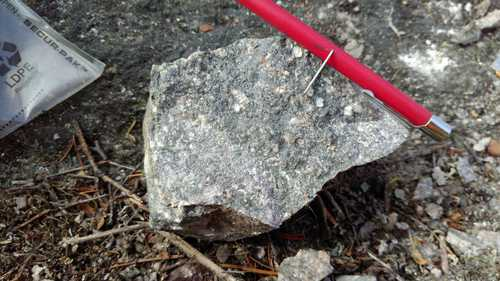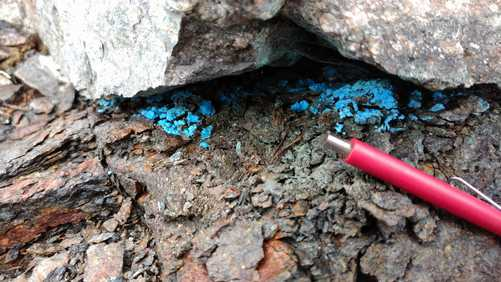Durango Returns High-Grade Grab Sample of 6,010 G/T Silver and 736 G/T Cobalt and High-Grade Channel Sample of 4.21% Copper at Dianna Lake
posted on
Dec 18, 2017 10:37PM

100% Interest in the Trove and East Barry Properties Adjacent to Osisko, Windfall, Quebec

(TheNewswire)
Vancouver, BC / TheNewswire / December 18, 2017 – Durango Resources Inc. (TSX.V-DGO), (the “ Company ” or “ Durango ”) is very pleased to report that, further to its news of August 31, 2017, the fire assay results from its Dianna Lake, Saskatchewan exploration program have returned high grade silver, copper and cobalt.
The main historical Pit No. 1 which was dewatered and sampled, returned five high grade grab samples ranging from 951 g/t to 6,010 g/t (0.95 to 6kg/t), with the average being 2,650 g/t Ag. All high-grade silver results were associated with highly anomalous cobalt (ranging from 560ppm to 736ppm). Grab samples are selective by nature and may not be representative of the mineralization hosted on the property.
Native silver was found in historic Pit No. 1, where it was observed together with erythrite. The erythrite is a hydrated cobalt arsenate (Co3 (AsO 4 ) 2 ·8H 2 O) rose color mineral , (see Figure 1). The cobalt (erythrite) makes an isomorphous mixture with nickel (annabergite) (Ni 3(AsO 4 ) 2 .8H 2 O) known also as “cobalt and nickel blooms”, and has been mentioned in the previous historical exploration reports in the area. The copper grade reached 4.21% in a 50cm by 5cm channel sample. The highest grade of Ag was 6,010 g/t in a grab sample. The highest-grade nickel was 0.92% in a grab sample. The highest tungsten grade was 0.2% which occurred in the same 50cm by 5cm channel sample that returned 2.68% copper. The highest lead grade was 3.29%, and zinc grade was 1.07% in the same grab sample. The rhenium reached values of 0.997 g/t in a 50cm by 5cm channel sample with returned 1.65% copper. The highest-grade scandium graded 26.2 g/t in a grab sample. G rab samples are selective by nature and may not be representative of the mineralization hosted on the property.
image: https://www.thenewswire.com/data/tnw/clients/img/45c984144682bbf3358b3d130086c3ce_.png

Figure 1. Native silver with Erythrite (Co 3 (AsO 4 ) 2 ·8H 2 O).
The north trench zone returned 16 high grade copper results (ranging from 1.01% to 4.21%), with the average being 1.85% Cu. Twelve of the high-grade copper results were obtained via channel sampling over a 50cm long by 5cm wide channels. Each of these 50cm long channels returned copper as follows: 4.21%, 2.94%, 2.68%, 2.44%, 1.89%, 1.86%, 1.65%, 1.56%, 1.42%, 1.24%, 1.09% and 1.05%. The remaining four samples were obtained by grab samples and returned copper values as follows: 1.69%, 1.57%, 1.08% and 1.01%.
Twenty-seven anomalous copper results were taken from an area a long a geological contact (between biotite gneiss and a schist zone) with spectacular oxidation of a copper rich zone characterized by blue oxidation, (see Figure 2). This zone can be observed as 6m long by 3m wide.
The mineralization zone is enriched by silver, gold, cobalt, copper, mercury, nickel, lead, zinc, rhenium, scandium, antimony, tungsten and Rare Earth Element, and depleted by aluminum, calcium, potassium, and natrium.
Mineralization can be described as a complex copper-gold, silver-mercury, arsenic and sulfoarsenic nickel-cobalt type. This mineralisation may potentially resemble the Kaiser Bill copper-silver deposit which is in Georgetown Inlier, Northern Queensland in Australia.
image: https://www.thenewswire.com/data/tnw/clients/img/e530e233c7b7b6a77d9061ad58329e50_.png

Figure 2. Blue oxidation mineral from the high-grade Copper mineralization zone.
These exceptional results support the high-grade potential of the Dianna Lake property. Historical drilling conducted by Comaplex Resources demonstrated similar grades in a previous exploration program. The impressive results from both within and outside of previously documented showings, pits and trenches of the Dianna Lake property are compelling and warrant follow-up work by Durango.
Planning for additional exploration and a drilling program in 2018 is underway to further define local geology and mineralization on the property. Stripping is recommended due to the exposed rock with mineralization at or very near to the surface of the main mineralized zones. Systematic channel sampling on prospective areas is also recommended to test the continuity of the mineralization. Further exploration around the known zones is necessary to verify any extensions. Drilling holes of up to 20-30m depth for proving historical anomalies will be essential to prove the continuity at depth and can be performed concurrently with the stripping and channel sampling.
A charged body geophysics method should be implemented for contouring the prospective area for any mineralized body. It is also expected that the proposed work program will include gamma radiometric mapping, and, if positive results are achieved, the gamma radiometric spectroscopy for analyzing the potassium, uranium and thorium. Field mercury-vapor analysis during the windless summer days on the perspective areas is also recommended. Outcrop detailed sampling by quadratic grid on more perspective areas should be done. Drilling works on quadratic grid should be undertaken for boundary tracking of the ore bodies and resources evaluation.
In addition to sampling, the Durango crew completed approximately 7 km of magnetic/gradient and one kilometre of VLF in the immediate area of the historical workings to compare with historical reports. The interpretation and results of this work are expected to be reported later as they become available in a technical report for the Dianne Lake property.
Project geologist George Yordanov stated, “Our work program has uncovered really exciting geology that correlates with historical figures resulting from previous exploration programs where high-grade mineralization was identified at or near surface.”
Marcy Kiesman, CEO of Durango, further commented, “Durango is so pleased that our exploration program has discovered high grade silver, copper and cobalt at our Dianna Lake property. Our team is focused on planning a detailed follow-up exploration program at Dianna Lake when weather permits in the coming months. We are looking forward to bringing more value to our shareholders in what is shaping up to be an exciting year ahead as Durango continues to advance its compelling assemblage of mineral projects.”
About the Dianna Lake property, Saskatchewan
Durango's Dianna Lake silver property covers a historical area in which, from 1968 to 1969, two high-grade, primarily native, silver-bearing exploration targets of between 30,000 tonnes and 50,000 tonnes grading five to 10 ounces per ton silver, approximately 600 metres apart, were determined by trench grab sample assays, according to a historical evaluation report composed for Comaplex Resources in 1980* (1).
- Potential quantities and grades are conceptual in nature. There has been insufficient exploration to define a mineral resource, and it is uncertain if further exploration will result in the target being delineated as a mineral resource.
Additionally, the main silver-bearing zone is spatially associated with a large zone of low-grade, disseminated copper-silver mineralization in which drilling of two IP anomalies indicated approximately five million tonnes averaging 0.4 ounce per ton silver and 0.4 per cent copper (undefined category historical resource estimate, undocumented method), according to the same report** (1).
-- A qualified person has not done sufficient work to classify the historical estimate as current mineral resources or mineral reserves, and Durango is not treating the historical estimate as current mineral resources or reserves. The historical estimates use categories other than those required by the Canadian Institute of Mining, Metallurgy and Petroleum and National Instrument 43-101. Further research and exploration work must be carried out to verify all historical information before a resource estimate is possible.
Previous work on the claims was reported in 1969, 1980 and 1998, and included diamond drill holes, trenches and pits primarily across two zoneswhere mineralization was identified at or near surface . *** One zone was reported to have five trenches exposing silver-copper mineralization over approximately 80 metres. Historical grab samples from pit No. 1 of this zone included values of 2,458.4, 684.4, 647.4, 600.2, 464.2 and 454.8 ounces per tonne silver. Out of 18 grab samples, 13 samples assayed between 185 ounces per tonne silver and 2,458.4 ounces per tonne silver. Pit No. 2 grab samples returned reported highs of 298 ounces per ton silver and 197 ounces per tonne silver (out of seven samples ranging from 12.2 ounces per ton silver to 298 ounces per tonne silver) (1). The Company cautions that grab samples are selective and may not be representative of the mineralization on the property.
--- A qualified person has not done sufficient work to verify, analyze and test the data underlying the previously filed government work reports created for the property. The historical information and data is being used for information purposes only until it can be verified by the Company through additional exploration work.
The technical contents of this release were approved by George Yordanov, P.Geo, a “qualified person” as defined by National Instrument 43-101. The property has not yet been the subject of a National Instrument 43-101 report.
About Durango
Durango is a natural resources company engaged in the acquisition and exploration of mineral properties. The Company has a 100% interest in the Mayner’s Fortune limestone properties in northwest British Columbia, the Decouverté and Trove gold properties in the Abitibi Region of Quebec, and certain lithium properties near the Whabouchi mine, the Buckshot graphite property near the Miller Mine in Qu ébec, the Dianna Lake silver project in northern Saskatchewan, and the Whitney Northwest property near the Lake Shore Gold and Goldcorp joint venture in Ontario .
For further information on Durango, please refer to its SEDAR profile at www.sedar.com.
Marcy Kiesman, Chief Executive Officer
Telephone: 604.428.2900 or 604.339.2243
Facsimile: 888.266.3983
Email: durangoresourcesinc@gmail.com
Website: www.durangoresourcesinc.com
Forward-Looking Statements
This document may contain or refer to forward-looking information based on current expectations, including, but not limited to the development, commencement and completion of a National Instrument 43-101-compliant technical report, the completion of future exploration or project exploration programs at the Dianna Lake property and the impact on the Company of these events. Forward-looking information is subject to significant risks and uncertainties, as actual results may differ materially from forecasted results. Forward-looking information is provided as of the date hereof and we assume no responsibility to update or revise them to reflect new events or circumstances. For a detailed list of risks and uncertainties relating to Durango, please refer to the Company's prospectus filed on its SEDAR profile at www.sedar.com .
Neither TSX Venture Exchange nor its Regulation Services Provider (as that term is defined in the policies of the TSX Venture Exchange) accepts responsibility for the adequacy or accuracy of this release.
Read more at